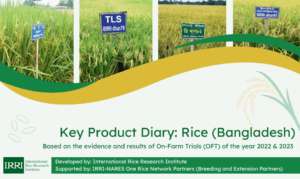Exotic varieties, without a doubt, contribute to food security and farmer welfare in Bangladesh; however, domestication of these cultivars poses a direct threat to the security and stability of national varietals. The replacement of native cultivars with non-native cultivars leads to a dramatic decrease in the genetic diversity of domestic crops. Moreover, the informal trade of varieties may not have been subjected to plant quarantine, posing a risk of pest and disease transmission. It also does not ensure compliance with national seed standards such as quality, purity, and minimum germination rate. Therefore, it is critical to provide cultivar reference information for future national rice breeding plans and related policies to prevent genetic erosion.
Farmers in Bangladesh grow a wide range of rice varieties, including exotic varieties. Exotic varieties contribute a significant portion of the country’s rice production, and the aggregate contribution of rice to the national economy is about 4.5%. In fact, exotic varieties account for 15.39% of total rice production. Poor documentation and proper recognition of the contribution of exotic varieties remain research gaps, that this study aims to fill.
To date, 134 rice varieties have been developed, with 106 developed by the Bangladesh Rice Research Institute (BRRI), 22 developed by the Bangladesh Institute of Nuclear Agriculture (BINA), and six from different universities. However, due to many constraints, such as proper seed distribution to farmers, rice production in the country is limited to a few varieties.
Farmers in the border region of Bangladesh have been cultivating exotic varieties since 1999. The adoption rate of exotic varieties has increased because of population growth, rapid human mobility, environmental change, and the exchange of more goods and materials.
In 1998–99, the government of Bangladesh decided to import hybrid rice seeds from abroad for on-farm trials to increase farm productivity. In response, about 600 metric tons of seed from four varieties in India and one variety in China were imported via public-private partnership.
Farmers in the northwest region unofficially adopted some Indian rice cultivars through cross-border seed exchange. Swarna, for example, was developed in Andhra Pradesh, India, in 1982 and is being gradually adopted in the Rajshahi district since 1999.
According to BRRI , exotic varieties accounted for approximately 6%, 10%, and 22% of total pre-monsoon, dry, and wet season rice areas in 2019–20, respectively. Questions arise, such as why exotic varieties are being adopted at such a rapid rate.
What factors influence the acceptance of exotic cultivars?
Exotic varieties, without a doubt, contribute to food security and farmer welfare in Bangladesh; however, domestication of these cultivars poses a direct threat to the security and stability of national varietals. The replacement of native cultivars with non-native cultivars leads to a dramatic decrease in the genetic diversity of domestic crops.
Also, domestic rice cultivars are valuable genetic resources for future varietal improvement programs intended for the agro-climatic environment. Moreover, the informal trade of varieties may not have been subjected to plant quarantine, posing a risk of pest and disease transmission.
It also does not ensure compliance with national seed standards such as quality, purity, and minimum germination rate. Therefore, it is critical to provide cultivar reference information for future national rice breeding plans and related policies to prevent genetic erosion.
This study aims to establish guidelines for national rice breeding programs for the development of new varieties, with an emphasis on the traits of exotic varieties that farmers prefer in Bangladesh. Despite the issue being important for its implications for domestic varietal security and local biodiversity conservation, there have been few studies on it.
We have addressed the gap that previous studies overlooked. The study first looks at the adoption status of both exotic and domestic varieties in the study areas.
Second, identify the primary drivers affecting farmers’ preferences for exotic and domestic rice varieties.
Third, determine the factors influencing the adoption intensity of exotic rice varieties using an econometric model.
Finally, the study made policy recommendations to assist the national breeding program in developing and disseminating future domestic rice varieties in Bangladesh to increase farmers’ welfare and ensure food security.
Farmers in the border region of Bangladesh prefer exotic varieties that have yield advantage, higher market price, less inputs requirement, higher profitability, better agronomic qualities such as lower risks of infestation by pests and diseases, a better aptitude to fit in various cropping patterns, quick recovery capacity from stresses especially drought, less labor requirements, and other socio-economic factors such as education, occupation, and family labor.
Unless new, improved domestic varieties can compete on these factors, exotic varieties will most likely continue to dominate. Researchers, policymakers, extension personnel, and farmers must collaborate to identify and develop the most viable market-driven breeding alternatives to mitigate the potential effects of an over-reliance on exotic varieties.
These technologies could have remarkable impacts in accelerating farmers’ welfare and sustaining food security in Bangladesh. The findings are also helpful for other rice-growing countries for the same purposes.
Read the study:
Sarkar Md AR, Rahman MC, Rahaman Md S, Sarker MdR, Islam Md R, Balie Jean, Kabir Md. S (2022) Adoption determinants of exotic rice cultivars in Bangladesh. Frontiers in Sustainable Food Systems. Vol 6.






